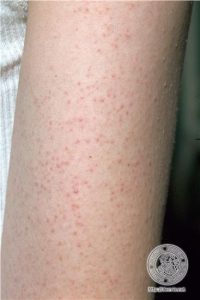SERVICES
- Allergy Screening
- Chemical Peels
- Dermapen
- Facial Skin Analysis
- FreshEyes
- Hyperhidrosis (Excessive Sweating)
- Hair Loss Treatment
- Laser Clinic
- Liquid Facelift
- Keloid Treatments
- Medical Facials
- Medical Treatments
- Mole Mapping
- Photodynamic Therapy (PDT)
- Skincare Advice
- Pigmentation Treatment
- Surgical Procedures
- Ultraviolet Phototherapy
USEFUL LINKS
What is keratosis pilaris?
 Keratosis pilaris is a very common and completely harmless skin condition. In the population as a whole, keratosis pilaris may affect as many as one person in three. Its name gives some idea of what it is; ‘keratosis’ means that there is too much keratin, which makes up the tough horny outer layer of the skin, while ‘pilaris’ comes from the Latin for hair (pilus). In keratosis pilaris, many small (1 to 2 mm across) horny plugs can be seen blocking the hair follicles on the upper and outer parts of the arms and thighs. This can look like goose bumps, but feels slightly rough.
Keratosis pilaris is a very common and completely harmless skin condition. In the population as a whole, keratosis pilaris may affect as many as one person in three. Its name gives some idea of what it is; ‘keratosis’ means that there is too much keratin, which makes up the tough horny outer layer of the skin, while ‘pilaris’ comes from the Latin for hair (pilus). In keratosis pilaris, many small (1 to 2 mm across) horny plugs can be seen blocking the hair follicles on the upper and outer parts of the arms and thighs. This can look like goose bumps, but feels slightly rough.
What causes keratosis pilaris?
Keratosis pilaris is an inherited skin condition, running strongly in many families, sometimes with a dry skin condition (such as ichthyosis). The way it is inherited varies from family to family, but it often fits into an ‘autosomal dominant’ pattern; this means that there will be a 1 in 2 chance that each child of an affected parent will inherit the condition.
Keratosis pilaris appears when extra keratin accumulates in the hair follicles. This is usually in childhood, and most obvious during adolescence, often clearly in adulthood. For reasons not fully understood the condition seems to be better in the summer than in the winter. Keratosis pilaris is harmless, and is not infectious.
Is keratosis pilaris hereditary?
Yes, see above.
What are the symptoms of keratosis pilaris?
Some people find their keratosis pilaris looks unattractive. The skin feels rough or spiky, as though it has permanent goose bumps. Occasionally keratosis pilaris is itchy.
What does keratosis pilaris look like?
The groups of small spiky bumps are most common on the backs of the upper arms and on the fronts of the thighs. Sometimes keratosis pilaris also affects the back and chest and, in less common forms, the face and eyebrows as well. Some redness may appear around the small spiky bumps.
How will keratosis pilaris be diagnosed?
There are no specific tests for keratosis pilaris; however, your doctor will recognise it easily. A biopsy is seldom needed.
Can keratosis pilaris be cured?
No, but often it does clear up during adult life.
How can keratosis pilaris be treated?
No treatment clears keratosis pilaris satisfactorily, and ordinary emollients (moisturisers) are of limited benefit. Creams containing salicylic acid, lactic acid and/or urea are sometimes felt to be more effective, and can be purchased over the counter or obtained under prescription. In many cases it may be best to wait for the problem to improve on its own.
Self Care (What can I do?)
General measures to reduce skin dryness may help:
- Use mild soaps
- Apply emollients (moisturisers) frequently
- Have tepid showers rather than hot baths
- The use of an exfoliator may sometimes be of help
Patient Testimonials
EXCELLENTTrustindex verifies that the original source of the review is Google. From my first visit with Dr Jhetam I knew I would go back. He is compassionate , friendly and has an interaction which made you feel comfortable. This is very important in any doctor because our relationship with our doctor is very intimate.Trustindex verifies that the original source of the review is Google. Dr Jhetman is truly one of a kind. Anyone who is fortunate enough to be in his care can so grateful. Academic, informative and reassuring. It’s hard to find a doctor who has this combination of skills these days. He dealt with my Melonoma concerns with swift and professional care. And his staff are equally as competent and caring. I cannot commend Dr Jhetman and his staff enough on true patient care. Thank you!Trustindex verifies that the original source of the review is Google. I was absolutely satisfied with my experience with Dr Jhetham & his winning team. Keep up the good work.Trustindex verifies that the original source of the review is Google. Best skin doctor..Dr Jetham prescribed the best products that have brought so much of a glow to my skin..being a transplant patient and so much happening to my skin just 4 visits to him and my face is back to it's radiance ..I hightly reccomend Dr Jetham ...you won't go wrong..Trustindex verifies that the original source of the review is Google. Dr. Imraan Jhetam and his team provided exceptional care, showcasing professionalism and compassion in every interaction. Dr. Jhetam took the time to thoroughly explain everything, addressing each of my concerns with empathy and understanding. My experience with him was truly wonderful, and I highly appreciate his dedication to patient care.Verified by TrustindexTrustindex verified badge is the Universal Symbol of Trust. Only the greatest companies can get the verified badge who has a review score above 4.5, based on customer reviews over the past 12 months. Read more



